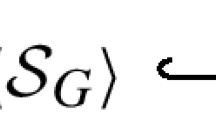Abstract
In this paper, we give a precise and workable definition of a quantum knot system, the states of which are called quantum knots. This definition can be viewed as a blueprint for the construction of an actual physical quantum system. Moreover, this definition of a quantum knot system is intended to represent the “quantum embodiment” of a closed knotted physical piece of rope. A quantum knot, as a state of this system, represents the state of such a knotted closed piece of rope, i.e., the particular spatial configuration of the knot tied in the rope. Associated with a quantum knot system is a group of unitary transformations, called the ambient group, which represents all possible ways of moving the rope around (without cutting the rope, and without letting the rope pass through itself.) Of course, unlike a classical closed piece of rope, a quantum knot can exhibit non-classical behavior, such as quantum superposition and quantum entanglement. This raises some interesting and puzzling questions about the relation between topological and quantum entanglement. The knot type of a quantum knot is simply the orbit of the quantum knot under the action of the ambient group. We investigate quantum observables which are invariants of quantum knot type. We also study the Hamiltonians associated with the generators of the ambient group, and briefly look at the quantum tunneling of overcrossings into undercrossings. A basic building block in this paper is a mosaic system which is a formal (rewriting) system of symbol strings. We conjecture that this formal system fully captures in an axiomatic way all of the properties of tame knot theory.
Similar content being viewed by others
References
Aharonov, D., Jones, V., Landau, Z.: On the quantum algorithm for approximating the jones polynomial. http://arxiv.org/abs/quant-ph/0511096
Chen, G., Kauffman, L., Lomonaco, S.J. (eds.): The Mathematics of Quantum Computation and Quantum Topology. Chapman & Hall/CRC (2007)
Collins, G.P.: Computing with quantum knots. Sci. Am. April, 56–63 (2006)
Crowell, R.H., Fox, R.H.: Introduction to Knot Theory. Springer-Verlag (1977)
Helstrom, C.W.: Quantum Detection and Estimation Theory. Academic Press (1976)
Jacak, L., Sitko, P., Wieczorek, K., Wójs, A.: Quantum Hall Systems: Braid groups, Composite Fermions, and Fractional Charge. Oxford University Press (2003)
Kauffman, L.H., Lomonaco, S.J.: Quantum knots. Proc. SPIE (2004). http://arxiv.org/abs/quant-ph/0403228
Kauffman, L.H., Lomonaco, S.J., Jr.: q-Deformed spin networks, knot polynomials, and anyonic topological quantum computation. J. Knot Theory 16(3), 267 332 (2007). http://xxx.lanl.gov/abs/quant-ph/0606114
Kauffman, L.H., Lomonaco, S.J., Jr.: Spin networks and anyonic topological computing. Proc. SPIE 6244 (2006). http://xxx.lanl.gov/abs/quant-ph/0603131
Kauffman, L.H.: Knots and Physics, 3rd edn. World Scientific (2001)
Kitaev, A.Y.: Fault-tolerant quantum computation, by anyons. http://arxiv.org/abs/quant-ph/9707021
Leonhardt, U.: Measuring the Quantum State of Light. Cambridge University Press (1997)
Lickorish, W.B.R.: An Introduction to Knot Theory. Springer (1997)
Lomonaco, S.J.: The modern legacies of Thomson’s atomic vortex theory in classical electrodynamics. AMS PSAPM/51, Providence, RI, pp. 145–166 (1996)
Lomonaco, S.J., Jr., Kauffman, L.H.: Topological quantum computing and the Jones polynomial. Proc. SPIE 6244 (2006). http://xxx.lanl.gov/abs/quant-ph/0605004
Lomonaco, S.J., Jr.: A Rosetta stone for quantum mechanics with an introduction to quantum computation. PSAPM, 58, AMS, Providence, RI, pp. 3–65 (2002)
Lomonaco, S.J., Jr. (ed.): Quantum computation. PSAPM, 58, American Mathematical Society, Providence, Rhode Island (2002)
Lomonaco, S.J., Jr.: Five dimensional knot theory AMS CONM 20, 249–270 (1984). http://www.cs.umbc.edu/~lomonaco/5knots/5knots.pdf
Lomonaco S.J., Jr (1981) The homotopy groups of knots I. How to compute the algebraic 3-type. Pacific J. Math. 95(2): 349–390
Murasugi, K.: Knot Theory and Its Applications. Birkhauser (1996)
Nielsen, M.A., Chuang, I.L.: Quantum Computation and Quantum Information. Cambridge University Press (2000)
Peres, A.: Quantum Theory: Concepts and Methods. Kluwer (1993)
Rasetti, M., Regge, T.: Vortices in He II, current algebras and quantum knots. Physica 80 A, North-Holland, pp. 217–233 (1975)
Sakuri J.J.: Modern Quantum Mechanics, revised edn. Addison-Wesley (1994)
Shankar, R.: Principles of Quantum Mechanics, 2nd edn. Plenum (1994)
Sarma S.D., Freedman M., Nayak C. (2005) Topologically protected qubits from a possible non-Abelian fractional quantum hall state. Phys. Rev. Lett. 94: 166802-1–168802-4
Shor, P.W., Jordan, S.P.: Estimating Jones polynomials is a complete problem for one clean qubit. http://arxiv.org/abs/0707.2831
Wen, X.-G.: Quantum Field Theory of Many-Body Systems. Oxford Press (2004)
Zee, A.: Quantum Field Theory in a Nutshell. Princeton University Press (2003)
Madison K.W., Chevy F., Wohlleben W., Dalibard J. (2000) Vortex formation in a stirred Bose-Einstein condensate. Phys. Rev. Lett. 84: 806–809
Author information
Authors and Affiliations
Corresponding author
Rights and permissions
About this article
Cite this article
Lomonaco, S.J., Kauffman, L.H. Quantum knots and mosaics. Quantum Inf Process 7, 85–115 (2008). https://doi.org/10.1007/s11128-008-0076-7
Received:
Accepted:
Published:
Issue Date:
DOI: https://doi.org/10.1007/s11128-008-0076-7




